Venus flytrap: description, types, cultivation and care
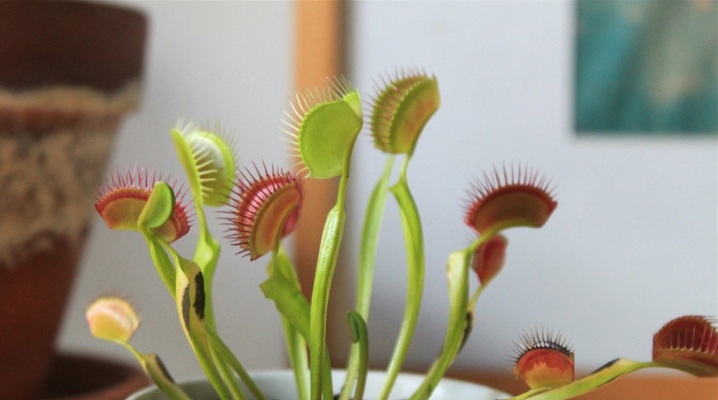
The Venus flytrap, Dionaea muscipula (or Dionaea muscipula) is an amazing plant. It is rightfully considered one of the most exotic representatives of the flora, since it has an original appearance with aggressive features and a carnivorous character. Despite the exoticism, this fly-eater can settle on the windowsill of everyone. But before that, you need to familiarize yourself in detail with this amazing plant and study in detail all the subtleties of its content at home.
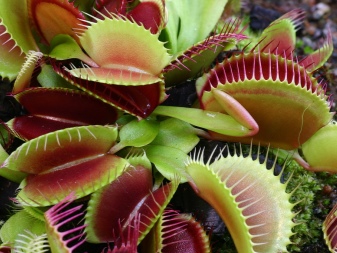

Description
This natural wonder grows in America, mainly in North and South Carolina. Here, on wet meadows and peat bogs, ideal conditions are formed for the life and development of this predator. Despite the high love for marshlands, stagnant water is detrimental to Dionea.
The Venus flytrap belongs to the sundew family. She happens to be herbaceous, insectivorous plant. Its rosette consists of 4-7 elongated leaf plates, the length of which does not exceed 7 centimeters. The stem is similar to a bulb with a length of up to 15 cm.


The flowers of a predatory exotic are inconspicuous: small, white, collected in inflorescences on a long peduncle.
Under natural conditions, Dionea prefers to grow on poor soils with a minimum nitrogen content.... The flower receives this component from its prey, which is various small insects and even slugs. After flowering, the flycatcher forms special leaves that serve as traps. Their design consists of two petals with bristles along the edge, which are capable of slamming.
On the outside, the petals are green and the inside is red. Traps attract prey not only with their original coloring, but also with nectar, which is produced by special glands. When an insect falls into a trap, it instantly closes and a digestive secretion begins to be produced.

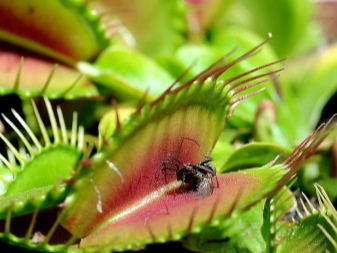
The digestion process can last from 5 to 12 days, upon completion of which the trap is reopened. One trap is on average capable of digesting up to three insects, but there are exceptions to the larger side. After that, the leaf dies off.

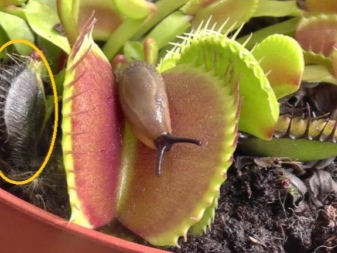
Landing
This process has special requirements that must be scrupulously followed.
- The plant thrives on poor soils. From the nutrient soil, the flycatcher simply will not be able to assimilate mineral salts, which will lead to its death. The best option is a mixture of quartz sand and high moor peat. These components are taken in equal parts.

- Along with preparing the soil, do not forget about choosing a container for planting. Many growers use glass containers like aquariums. They retain moisture better, and the plant is protected from drafts. A regular flower pot can also be used. It should be up to 12 cm wide and about 20 cm deep. The plant will thrive better in a light pot, as in this case the roots will not overheat. There must be drain holes and a sump.

- The ground part of the plant loves the sun, which cannot be said about its root system.... So that the roots do not suffer, it is advisable to cover the substrate with wet moss. The moss can also be placed in a pallet to maintain optimal moisture levels.

If no questions arise with the preparation process, you can proceed directly to the transplant. A flower that was purchased from a store must be repotted immediately. This procedure is performed according to a certain scheme.
- The plant is removed from the container, its roots are carefully cleaned from the old substrate... They can also be rinsed in warm, distilled water.
- In a prepared pot the substrate is laid out on the bottom (drainage is optional).
- There is a flower in the center of the pot, its roots, together with the stem, are covered with prepared soil. No need to tamp. We water the plant and put it in a shaded place.
- The adaptation process will last for a month. At this time, the plant needs good watering and shelter from the sun.

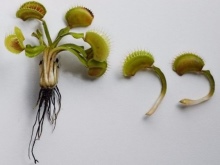

The Venus flytrap does not need to be repotted regularly, since the soil is not depleted, therefore, does not need to be updated.
Moreover, the flower takes a long and difficult time to get used to new conditions, therefore it is better not to shock it in the absence of an urgent need for it.
Home care
This indoor flower is very capricious and demanding. It is difficult to grow it, so either experienced florists or scrupulous amateurs can do it. To grow a Venus flytrap at home, you must clearly adhere to certain rules for keeping.
- Lighting is required intense, but diffused. The plant will thrive on east and west windows. When located on the south side, the flower will have to be constantly shaded, protecting it from direct sunlight. Daylight hours should be about 13 hours, therefore, in the spring and autumn you will have to take care of additional lighting.

- Fresh air has a beneficial effect, therefore frequent ventilation is a priority... But the overseas predator must be protected from drafts. Dionea also does not like to be disturbed, so there is no need to twist the pot with the plant and often change its position.

- Temperature conditions are also important for the normal development of a foreign visitor. Venus flytrap is a heat-loving plant. During the period of active growth, she needs to ensure a temperature of at least +22 degrees. The upper limit is at around +30 degrees, but it can be increased. With the onset of winter, the flower goes into a dormant period, which takes place at a temperature of +7 degrees. A stable high temperature throughout the year is detrimental to the plant.

- Watering Is an important component of plant care. Watering errors often cause plant death. The Venus flytrap will only live in moist soil. It is important here not to overmoisten the soil so that it is not soggy. This condition must be observed constantly, throughout the year.

Watering should be done exclusively through drainage holes using a pallet. With top watering, the soil from above will be compacted, which will complicate the access of oxygen to the root system. This will lead to the inevitable death of the plant.
You need to use distilled water, since Dionea is bad for salts and compounds from tap water. In the absence of distilled water, melt water or rainwater can be used, but it must be collected outside the city, away from roads and industrial facilities. Watering Dionea is necessary until moisture forms in the pan.

Also an important point is the temperature of the water used for irrigation. Using cold water in summer is a shock to a moody plant. If in winter you even slightly waterlogged the soil with warm water, then the Venus flytrap will take this action as a signal to wake up - hibernation will be interrupted, which will not have a beneficial effect on the flower.
Feeding this special plant is also special.... Fertilizers cannot be used, as this can lead to decay of the root system. But you need to provide the Venus flytrap with natural food. This plant is a predator and feeds on various insects in nature. With a sufficient amount of animal food, Dionea will develop and grow normally.


Not every insect can be offered to the Venus flytrap. It must meet a number of requirements:
- the size of the prey should be 2 times smaller than the trap, otherwise, it will not cope with such a volume of food, it will turn black and die;
- insects with a hard shell are difficult for the plant to digest.


One Dionea insect is enough for about 3-4 weeks. If the trap does not work, then the flower does not need animal food. You cannot force-feed a flower.
In winter, the Venus flytrap does not need to be fed at all, because she is in a dormant period. For the warm period of the year, the flower can be taken out to the balcony or in the garden altogether - he will catch prey himself and feed himself.

Diseased and weakened plants cannot be fed. After transplanting, insects cannot be offered for a month. In any of these options, the processing of animal food will be difficult, which will further weaken Dionea.
- During the flowering period, which begins in May or June, a peduncle is shown from the outlet. Its length can reach 50 cm. The peduncle ends with a corymbose inflorescence, which is formed by miniature white flowers in the form of stars. The flowering process lasts up to two months. The plant spends a lot of energy on flowering, therefore it is often weakened. Healthy, strong traps are not always formed after full flowering. Experts advise to cut the peduncle without waiting for the flowers to form.


- Wintering - this is a mandatory step that the Venus flytrap must go through every year. If the plant has managed to rest well, then it will be able to develop normally. Preparation for hibernation begins in October - Dionea no longer releases new leaves and discards old ones. This makes the outlet noticeably smaller. This behavior serves as a signal to stop feeding, reduce the frequency and intensity of watering.


During the winter, the soil should be kept slightly damp. With abundant watering or lack of moisture, the plant dies. In early December, the flycatcher pot is exposed in a cool place, perhaps with a little light. The temperature must be maintained within the range from +2 to +10 degrees.
Such conditions can be provided at home by wrapping the plant in a bag and placing it on a glazed loggia or in the lower drawer of the refrigerator.
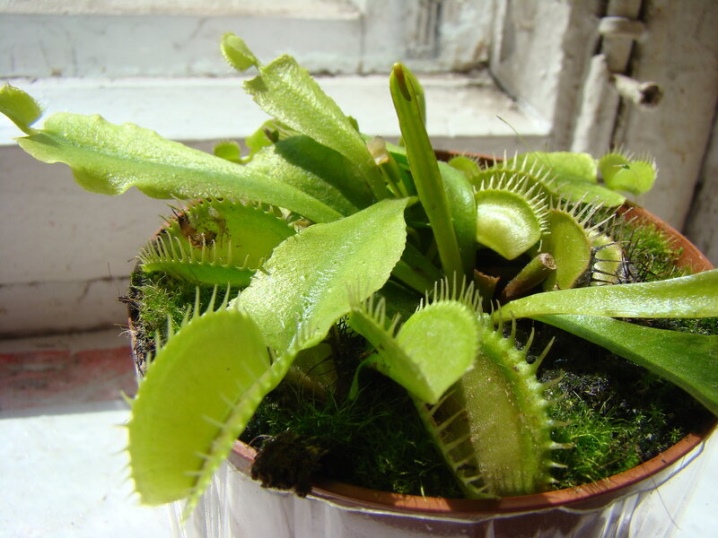
In this form, the flycatcher can be kept for up to 4 months. With the arrival of February, the plant can already be returned to warmth, light and abundant watering. You can also free the outlet from old traps.
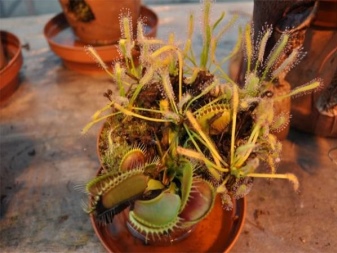

How does it multiply?
Reproduction of this exotic representative of the flora is possible in several ways.
For propagation by cuttings, you must cut off the leaf without a trap... The cut site is processed by "Kornevin", the leaf is planted in a container with peat, to which you can add sand. The substrate should be moist, but not wet. The lid is closed and the container is exposed in a warm place with good lighting. Such conditions must be observed for three months - until sprouts appear. From this moment, it will take another three months for a full-fledged sprout to be planted on a permanent place of "residence".

Bulb separation is only possible when the plant is mature. The Venus flytrap feels comfortable in close proximity with its children. Each branch of daughter bulbs is stressful for an adult plant, then this procedure can be carried out once every three years. The babies are carefully separated from the mother plant and placed in separate containers. It is better to cut the cut with crushed coal.For the rooting period, the children are covered with foil and exposed in a bright place without direct sunlight.

Seed propagation is also typical for Dionea. This method is the most difficult of all. Moreover, it is also unpredictable, since the new plant may be completely different from the mother. Seeds can only be given by an adult Dionea, which is more than three years old. To propagate Dionea by seed, you must adhere to the following guidelines:
- in spring, during flowering, it is necessary with a brush or cotton swab collect pollen and transfer to other flowers;
- upon successful pollination, a seed capsule is formed, which will ripen only in the fall and give full-fledged seeds;
- planting material must be planted immediately in the substrate, since their germination rate will decrease in the future;
- planting of seeds is carried out in containers with lidsfilled with sphagnum and sand (2: 1);
- seeds treated with "Topaz" laid out on a damp substrate, the container is closed and left in a sunny place;
- throughout the month you need to maintain maximum humidity, the temperature is within 25 - 30 degrees and the illumination is at least 12 hours a day;
- when the first leaves appear the container must be ventilatedgradually accustoming seedlings to fresh air;
- strengthened plants can dive.




The peduncle can also propagate the Venus flytrap. Usually, a peduncle is cut off on a young plant, which will find it difficult to cope with it and survive flowering safely.
To obtain a plant in this way, you must adhere to the following recommendations:
- a low, young peduncle about 5 cm long is cut off;
- placed in wet peat with a depth of 1 cm;
- greenhouse conditions are created - the container is covered with a film or a cap made of transparent material;
- the rooting process will take up to 2 months - during this period you need to maintain a high level of humidity and do not forget about airing;
- the peduncle may dry out, but you need to wait for the specified time and your patience will be rewarded.

Diseases
The Venus flytrap has excellent health and strong immunity, but in case of gross violations of the conditions of detention, various ailments can attack it. Timely detection of diseases and taking measures to eliminate them will save the plant.
- Fungus on the roots and gray rot on the leaves - this is the result of waterlogging of the soil and non-observance of the temperature regime. Fungicides are used for treatment.

- Bactericidal lesion is the result of the rotting of a caught prey, which the plant is unable to digest. In this case, the traps turn black and rot. The disease can rapidly move to other traps and infect the entire plant, which causes it to die in a short time. The blackened trap is removed and the dionea is treated with a fungicide.

- When watering with tap water, a large amount of calcium and other unsuitable substances accumulates in the soil... The leaves of the plant turn yellow. In this case, it is required to replace the soil as soon as possible and resume irrigation with distilled water. Otherwise, the plant will die.

- With irregular watering, the foliage also turns yellow, dries up and falls off. The problem is solved by resuming regular watering.

- Sunburns often appear on young leaves from direct sunlight. In this case, it is enough to shade the plant or rearrange the pot to another, more suitable place.

Pests
It is extremely rare to find pests on Dionea, but still such situations occur. A plant that feeds on insects can also suffer from them.
- Aphid can settle not only on the leaves, but also in the trap itself. The pest feeds on plant sap, which makes the traps deformed and cease to perform their functions. To save your pet from such a neighborhood, you need to purchase an insecticide, preferably in the form of an aerosol.

- Spider mite it can also settle on a flycatcher in conditions of low humidity. To get rid of this pest, it is necessary to treat the plant with "Acaricide" three times. Between treatments, you need to take a break of 7 days. It is also necessary to raise the humidity level to the recommended level, since spider mites cannot live in such conditions.

- Mealybug Is another common pest that can settle on overseas predators. Any suitable insecticide can be used to combat it.

Interesting Facts
The Venus flytrap has always attracted the attention of famous and outstanding people, therefore many interesting facts are associated with it.
- The third president of America, Thomas Jefferson, took an increased interest in this predator.... She occupied a special place in his collection of indoor plants. He even personally took care of her feeding and did not trust this process to anyone.
- Charles Darwin studied Dionea and even dedicated a separate book to her, in which the feeding process was described in detail.
- Flycatcher traps attract prey not only a bright color, a secret and a pleasant smell, but also a blue glow.
- Some plant varieties are able to determine the size of their prey. The flycatcher releases large insects that cannot be digested in the trap.
- Scientists are working to develop new varieties, which differ in color, color, size of traps and bristles. In botanical gardens, you can find plants with raspberry flaps. Their cost is very high.
For information on how to care for the Venus flytrap, see below.































The comment was sent successfully.